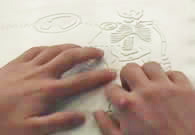Computer Assisted Tactiles (CATs)
Technology is providing many more options for producing quality tactile graphics in a more efficient time frame than in the past. The options range from
Standard braille embossers in graphics mode
Low resolution graphic modes are available in most standard embossers that many readers will recognize- Romeo, Juliet, Index, Versapoint, Thiel, etc. Low resolution means they can produce graphics at less than 18 dots per inch (dpi). The dots don't stray very far from the point that would produce a good braille cell, so they don't do as sophisticated a job at producing graphics as will high resolution embossers that are designed specifically to produce high quality graphics as well as braille text. Currently, QuickTac is the only program in the US that will support design of graphics for low resolution embossers. It is actually a re-design of part of an old program from Australia called TGD Pro, and being re-developed by Peter Sullivan of Duxbury. It can be used for graphics alone without DBT, however. There isn't anything available that allows you to import an image, translate it to a different image, and send to a low resolution embosser.
Braille and graphics embossers that produce high resolution graphics
In the US, there are 3 high resolution embossers marketed:
-
- Phoenix with Firebird software from Enabling Technologies, produced in US
- Index-Basic and Index-D V4 (latest model of Index) sold by IRIE-AT and others, produced in Sweden, uses TactileView software, produced in Netherlands
- ViewPlus Technologies' Tiger embossers with Tiger Software Suite (TSS), produced in US.
All of these embossers are capable of producing a dot much smaller than standard braille, much closer together, and in a much smaller grid configuration than standard braille embossers in graphics mode. Dot density for high resolution graphics is defined as 18 dpi or above. The embossers listed above range from 18 to 50 dpi.
From a scanned image, a variety of software can be used to re-design and emboss a quality tactile graphic, such as Photoshop, Illustrator, CorelDraw, and even MSWord. Less extensive (and free) programs such as Inkscape, XnView, Paint (built into Windows), InPaint, and Paint.net will also provide the features you need for re-design.
The Phoenix has its own proprietary design software built into Firebird with many features. TactileView has a full-featured tactile graphics editor as well. TSS from ViewPlus has a very simple "clean up" program. All three hardware/software combos involve a learning curve, some more than others. They also require some form of simple file conversion.
Phoenix and Index use a standard Library of Congress braille font for text. The Tiger font is slightly different from standard braille font.
Microcapsule paper and fuser (also called swell process)
The same software used to re-design print images for high quality embossed graphics can be used to produce an image that will become a "puffed" tactile graphic. The design principles are slightly different because of the properties of the capsule paper and the textures used to represent areas, lines and point symbols.
A short article about getting an image on paper can be found in the section just before this one, at www.tactilegraphics.org/microcapsule.html .
A different font must be used for braille titles and labels on capsule paper to accommodate the swelling of the dots. The dimensions of the braille cell are the same, but each braille dot is smaller in diameter. There are a number of free fonts and information about how to use them at the following sites:
Duxbury Systems--Braille True Type Fonts
TSBVI--Braille and ASL Specialty Fonts
gh MathSpeak--Downloads
RNIB--Braille Fonts
If you have a braille translation program installed, there are already braille fonts in your computer's fonts folder. Check to see if you have a font for capsule paper. Remember to not use simbraille fonts on capsule paper.

